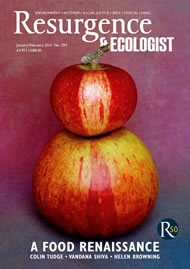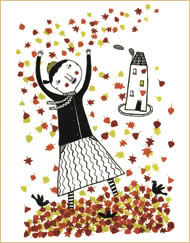Eco-warriors – why the furrowed brow, the long face?
There seems to be a prevalent assumption that ‘saving the planet’, eco-activism, environmental protection and all such matters green are serious. Can they be important without being serious?
Where is the joy, the passion, in seriousness? When we stop, breathe, feel and reflect quietly on seriousness, what qualities does this activate in us? Lightness of heart? Warmth and kindness? An inclination to reach out and connect compassionately with fellow human beings? How does seriousness actually help us do important work?
We are on the verge of, or maybe in the middle of, ‘interesting times’, as the back-handed salutation has it. We’re beginning to face global challenges that affect us all. We need to be active, effective and dynamic. Within our lifetimes we will all see more extreme human behaviour and possibly global convulsions. What can we do? The problems are prevalent and they are broadcast daily. We are subjected continuously to distressing images and newsfeeds, and as a result we probably all experience emotions such as anger, distress, disgust, sadness and outrage. How can we not?
However, is that the end of the story? What is the best way to respond? An eye for an eye? Despair and revenge? Hopelessness? Is there another quality we can tap into underneath all these emotions? In our core being, do we have a place of no surrender, of optimism and hope? A life-affirming place?
Can we find this place in spite of negative media bombardment? Can we access this place and choose to respond dynamically and positively? Can we find a ‘yes!’, come what may?
This is the place of triumph and joy.
At the latest Resurgence Summer Camp, Satish Kumar talked about joy, ananda: “Whatever you do, do it with joy.” Joy is invigorating. It is the antidote to despair. It is empowering, inspiring and energising. It is contagious. It gives hope and courage. Its natural partners are passion and enthusiasm, and these are highly charged energy, making us feel bright and alive.
Where is this joy? How do we find it? How do we activate it?
Happily, the answer to this question is readily available. As sages, mystics, yogis and others realised a long time ago, it is inside us all. It is sitting there, waiting for us. It is beaming a signal to us all the time, and our role is to listen. We need to distinguish between noise and signal and have the discernment to locate that still, small voice of calm in the middle of the din and distractions of life.
One way of locating it, as we explored at the Summer Camp, is to engage our whole being in its activation. Our whole being is much more than just our thinking process, and one of the many nuances we explored is how we can change our thinking process without thinking about it.
Here is a five-part model:
First, walk the walk. Remember: we are embodied beings. We are a physical embodiment of life, and our body consciousness carries a mass of information and intelligence. Get in touch with it. Move, breathe, stretch, pay attention, listen to its messages. Treat it as a friend. Include physical awareness as part of a daily routine. Be aware of how much we use it for communication, both emitting and receiving information. Play with your posture. Stand and sit with the posture of someone who’s delighted to be alive. Notice how a change in posture can alter how you feel – no thinking required. Notice how a joyful posture can activate enthusiasm and both the ability and the inclination to reach out and communicate.
Practical exercise: breathe slowly and deeply and direct your awareness to your feet, especially the soles of your feet. Feel them as strongly as you can. Simultaneously, feel your hands and fingers as strongly as possible. Include as many body parts as you can in your awareness, but especially your feet, and especially the soles of your feet. Keep practising.
Secondly, feel the feelings. When we invite qualities like warmth, kindness and happiness into our heart, they start to affect us in return. The practice is to become used to inviting in these qualities as a matter of choice. To some extent we do this anyway. How else would we all have managed to avoid jail for so long in the face of life’s daily provocations? What we sometimes don’t realise is that we can actively and consciously develop this as a practice, as heartily espoused by the Dalai Lama. In a joking way he has observed that the most selfish thing we can ever do is be kind to someone else, because what we emit is what returns. Whether done as a workshop exercise or a daily life practice, notice how it changes your relationship with life. In short, notice how quietly joyful you can feel when you do this.
Practical exercise: take your attention to your heart, feel it (figuratively) in the centre of your chest. Imagine it radiating out a field of warmth, ‘the milk of human kindness’, in every direction. Imagine this spread becoming as large as you can. Keep practising.
Thirdly, speak the words. Our subconscious, aka the Universe, is listening to us all the time. Our language is full of nuances that reveal exactly where we are in our life. Our language is not just the words. Our voice is also part of it. Using affirmative language – the word ‘yes!’ for example – has an energising quality. Giving and receiving affirmative language like praise, compliments and appreciation helps bring out the best in others and, when done genuinely, in ourselves too.
Delving more deeply into our voice, we discover that our whole body – not just our throat – is our vocal resonator, so we can start to see how all these pieces interlink and have the potential to support each other. Change your language, and you’ll change your mood, which will change your posture, and so on.
Practical exercise: practise making your outbreath audible. Picture your throat opening up like a large clear cylinder.
Say ‘yes’ to yourself silently, and if possible, aloud. Be alert to any changes this activates.
Pay someone a compliment, just for the sake of it – no returns.
Keep practising.
Fourthly, think the thoughts. The thoughts we think determine the life we experience. When we learn to take charge of our thinking process, we take charge of our life. Choosing to put attention on certain thoughts and types of thought, besides being an ancient practice, is also a certain way to optimism, happiness and joy. In the words of Alice Herz-Sommer, who at 109 was the longest-living survivor of the Nazis’ concentration camps, “I’m aware of the negative but I focus on the positive.” Herz-Sommer remained vital, optimistic and joyful through all her life’s experiences, by choosing what thoughts to give energy and attention to.
When we use a mantra like ‘Life is great’ or ‘It’s great to be alive’, we are fed by that positivity. When we’re in the presence of people who genuinely appreciate this, it helps imbue us with the same appreciation. In this way we can learn to notice and appreciate positive qualities in our life, with all the life-enhancement that accompanies this.
Fifthly, live the life. There is a lovely quotation attributed to Guillaume Apollinaire: “Now and then it’s good to pause in our pursuit of happiness and just be happy.” When we’re happy, we’re joyful, and when we’re joyful, we’re happy. When we spend a bit of time being in that state and not just striving for it, we start to experience it and wire it into our consciousness. We can all change, and learn to be more optimistic and joyful.
Practical exercise: stop, breathe, smile, feel, listen, and say ‘thank you’, frequently.
Finally, why? Why does joy matter?
The answer to this question is yet another thing we already know and sometimes forget: that when we are joyful, energised and in a good space, everything else in our life improves. We think better, we communicate better, we can manage our time better, and we deal with difficulties better. We are better parents, children, carers, citizens and even activists.
Perhaps our greatest contribution, no matter what we’re doing, is to be joyful? To remind ourselves of Alice Herz-Sommer’s philosophy? To accept that everything is as it is, but choose to deal positively and affirmatively with life? To look to effect inner and outer change from a strong, clear-sighted, grounded perspective, but with joyfulness and appreciation?
Aren’t these the outlooks of the people (such as Nelson Mandela, The Dalai Lama, Archbishop Desmond Tutu) we find most inspiring? Strong, clear and compassionate – yet joyful?
Why not us too?
Joe Hoare will be running the 25th Laughter Facilitation Skills course, 4th - 5th March 2016 at the Unitarian Chapel, Brunswick Square, St Paul's, Bristol, BS2 8PE. More information and bookings.








